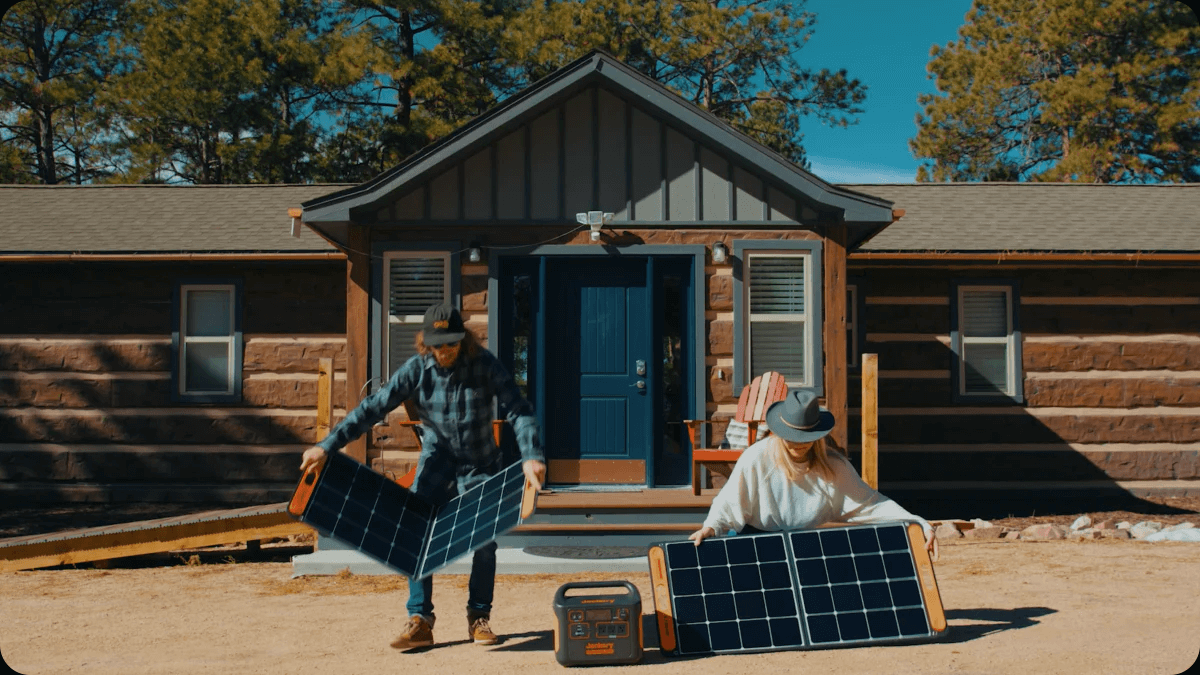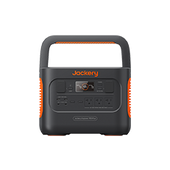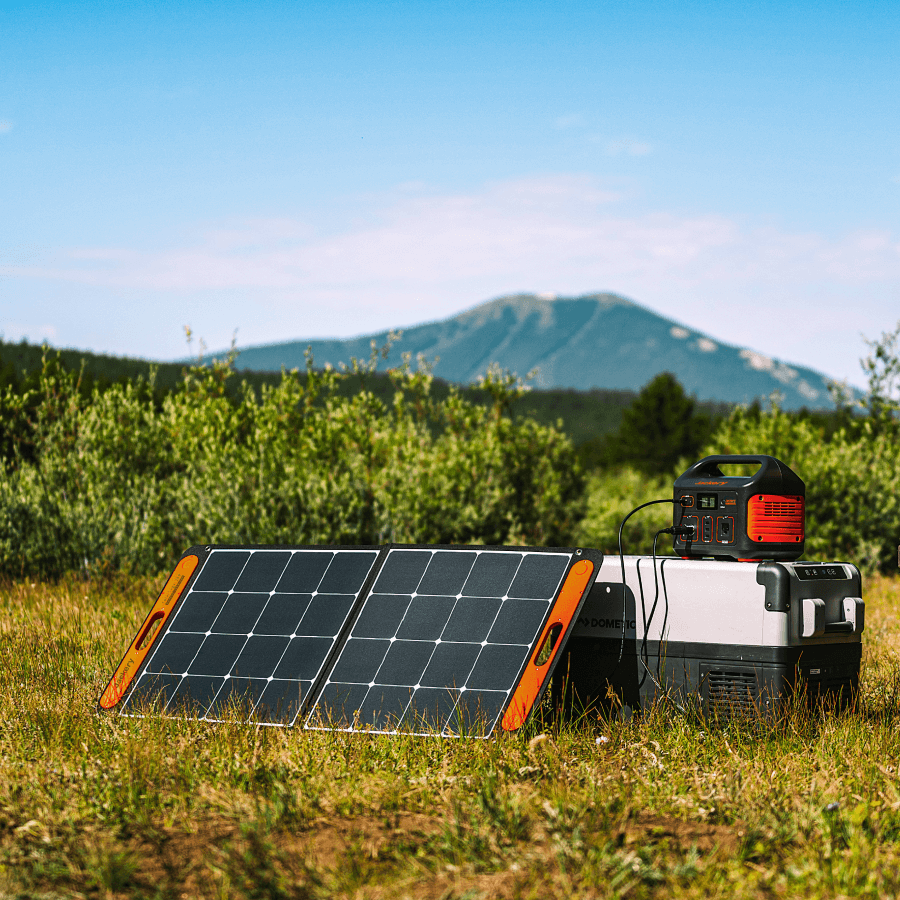The cost of solar electricity generation systems is reducing by 60%, so more people are transferring their energy requirements to solar energy. How many watts does a solar panel use? You need to know this to estimate how many solar panels you need to cover your power requirements. It also affects the cost-effectiveness of your solar installation and how soon you can break even the cost.
In 2024, you can purchase solar panels ranging from 100 watts to 200 watts from Jackery. Another critical concept to understand is that these figures are quoted for ideal conditions, such as bright sunlight and optimal temperature. With the weather changes, the efficiency of solar panels may change.
The Jackery solar panels are popular for their reliability and efficiency. The Jackery SolarSaga Solar Panels can reach up to 25% efficiency.
Solar Panel Wattage Key Takeaways
- Solar panels, ranging from 100 to 450 watts, are available in the market.
- Many factors affect the efficiency of solar panels, including sunlight exposure, roof shading, sunlight angle, and whether the sky is clear or cloudy.
- Solar generators may work with even lower numbers of solar panels as they can store energy.
- Generally, 15 to 25 solar panels are required to fulfill a common house power consumption.
How Many Watts Does A Solar Panel Produce?
Solar panels comprise small photovoltaic (PV) cells that convert sunlight into electricity. The more cells a solar panel has and the more efficient they are, the more energy it can produce. A solar panel's production is measured as its peak output in ideal conditions and is expressed in watts. The ideal conditions include peak sun hours, or the maximum wattage of a solar panel, which is its output in direct sunlight at 1000W/square meters. Other factors that can affect the output are temperature, shade, dirt, orientation, and tilt angle of the panel to the sun rays.
Standard Test Conditions (STC)
Standard testing conditions(STC) are the ideal laboratory conditions for testing all solar panels. The light source in the laboratory is maintained to fall on the PVC panel at 1,000 watts per square meter. The temperature was set at 77 degrees.
How Many Watts Per Hour Does A Solar Panel Produce?
The average solar panel production can vary depending on the location, the efficiency and size of the solar panels, the weather, and the time of year.
Using simple math, you can easily find how many watts a solar panel produces daily, weekly, and year. If your solar panel produces 200 watts an hour and you have 6 hours of sun exposure daily, then the solar power production of your panel is;
Solar power daily = solar panel wattage x hours of sunlight = 200 x 6 = 1200 watt hours
Solar power weekly = daily solar power production x 7
Solar power yearly = solar power weekly x 52
|
Type of Panel |
Per Hour |
Per Day |
Per Week |
Per Year |
|
Standard |
100 watts |
600 watts-hours |
4200 watt-hours |
218 kilowatt-hours |
|
Standard |
200 watts |
1200 watts-hours |
8400 watts-hours |
436 kilowatt-hours |
|
Standard |
250 - 400 watts |
1.5 - 2.4 kilowatt-hours |
0.5 - 16.8 kilowatt-hours |
546 - 874 kilowatt-hours |
How do you determine how much electricity A solar panel Produces?
Solar panels differ in manufacturing, efficiency, and output, so it is very difficult to exactly state how many watts a 100-watt solar panel produces or how many watts per hour a solar panel produces. Therefore, we will have to calculate numbers for each system individually.
Still, there is a general method to calculate and estimate your system's potential output carefully. Your system's output will follow the same pattern.
How Many Watts Does a Solar Panel Produce Per Day?
The average output of a solar panel in kilowatts is given by;
Step 1 = Size of one solar panel (in square meters) x 1,000
Multiply this number by the efficiency of your solar panel.
Step 2 = Step 1 x Percentage Efficiency of one solar panel
Every area has a different timespan of sunlight, so we must also incorporate this.
Step 3 = Step 2 x Number of sun hours daily
Divide this number by 1,000
The average daily output of your solar panel in kilowatts = Step 3 / 1000
So, if your solar panel measures 1.6 square meters in area, then we have the following;
Step 1 = 1.6 x 1,000 = 1,600
If the solar panel has 24% efficiency, then
Step 2 = 1600 x 0.24 = 384
Let us incorporate 6 hours of direct sunlight in your area;
Step 3 = 384 x 6 = 2304
Dividing by 1000
Total output of your solar panel daily = 2304/1000 = 2.304 kilowatt hours
How Many Watts Does A Solar Panel Produce Per Month?
Solar Panel Production Monthly = Average daily output of your solar panel x 30
What Factors Affect The Solar Panel Production?
The good news is that you can significantly increase your solar panel's production. We will now discuss the major factor affecting how many watts a solar panel produces.
- If your solar panels are placed under the shadows of trees or other objects, their output can be affected significantly, even to zero output.
- Weather and climate are other major factors, as we already discussed. However, it does not mean that high temperatures mean higher solar panel efficiency. We need optimal temperatures, as too high and too low can damage the panel and reduce the performance.
- The solar panels perform the best when exposed to the sun at the right angle and the roof is facing south. The ideal angle is 30 to 40 degrees for maximum production.
- Solar tracking is the method that uses single and dual-axis solar panels. These panels change their angle with the movement of sunlight, resulting in higher sun exposure time.
- Solar panels are available in three technologies, i.e., thin film, monocrystalline and polycrystalline. Monocrystalline offers the best efficiency, reaching up to 23%. However, choosing according to your budget, roof space, and required output would be best.
- Apart from the solar panels, the supporting equipment also contributes in the system's overall output. The solar inverters for solar generators, energy controls, and the cables connecting your house to the system must be of high quality to reduce transmission losses.
- Proper panel maintenance and cleaning to reduce any blockage to sunlight absorption increases overall production.
Jackery Solar Panels Explained
The Jackery solar panels are unique compared to regular solar panels because they are foldable and portable. You can also use them with a Jackery power station to make a portable solar generator. Despite being compact, they are rated at 23-25% efficiency, the industry's highest standard.

Jackery SolarSaga 500X Solar Panel
If you are looking for a solar panel with high power output, you can consider going ahead with the Jackery SolarSaga 500X Solar Panel. They are built by combining six Jackery SolarSaga 85 Solar Panels, each of which can be used individually. Paired with the Jackery Explorer 5000 Plus Portable Power Station, you can build a powerful home battery backup that can charge almost all household appliances.
Jackery SolarSaga 200W Solar Panel
The Jackery SolarSaga 200W solar panels are made of monocrystalline silicon solar cells and use multi-layered cell technology to generate solar power. The ETFE-laminated case makes these solar panels very durable, and an IP68 waterproof rating compliments it. The adjustable kickstands allow the adjustment to receive maximum sunlight and the highest performance.
Jackery SolarSaga 100W Solar Panel
The Jackery SolarSaga 100W solar panels are lightweight and portable, have kickstands for firm standing, and have an IP68 waterproof rating. All these features make them a perfect choice for outdoor and emergency home use. They have an ETFE-laminated design that ensures safety against extreme temperature and corrosion.
Jackery SolarSaga 100 Prime Solar Panel
The Jackery SolarSaga 100 Prime Solar Panel is designed for those who love RV or camping trips in remote locations. The solar panel can be installed on the rooftop of the RV or camper, ensuring maximum sunlight can be absorbed and converted into electricity. Pair these solar panels with the Jackery Explorer 1000 Plus Portable Power Station to build the Jackery Solar Generator 1000 Plus Roam Kit, which can charge 99% of RV appliances.
Jackery SolarSaga 40W Mini Solar Panel
The Jackery SolarSaga 40W Mini Solar Panel is suitable for those who prefer ultralight backpacking, hiking, fishing, or other short trips. It features two USB ports for directly charging two small appliances, such as phones and cameras. It can also be folded to iPad or book size and carried on short trips.
|
|
SolarSaga 500X Solar Panel |
Solar Panel 200W |
Solar Panel 100W |
SolarSaga 100 Prime Solar Panel |
SolarSaga 40W Solar Panel |
|
Peak Power |
500W |
200W |
100W |
100W |
40W |
|
Power Voltage |
41.7V±5% |
20V±5% |
18V |
18.7V±5% |
25V±5% |
|
Power Current |
12.0A±5% |
10A±5% |
5.55A |
5.30A±5% |
2.07A±5% |
|
Dimensions |
Folded: 39.21 × 20.71 × 3.82 in (996 × 526 × 97mm) Unfolded: 98.15 × 39.21 × 11.57 in (2493 × 996 × 294mm) |
Folded: 615 x 552 x 40 mm Unfolded: 2340 x 552 x 25 mm Weight: 6.4±0.3Kg |
Folded: 24 x 21 x 1.4 in (610 x 535 x 35 mm) Unfolded: 48 x 21 x 0.2 in (1220 x 535 x 5 mm) Weight:10.33 lbs (4.69 kg) |
Unfolded: 38.8 x 21.7 x 1.1in (986x552x29mm) |
Folded: 9.9×11.8×1.2 in (252×300×30mm) Unfolded: 40.1×11.8×0.7 in (1020×300×18.5mm) |
|
Waterproof |
IP68 |
IP68 |
IP68 |
IP68 |
IP68 |
|
Efficiency Rate |
25% |
24.3% |
24.3% |
24.3% |
23% |
|
Compatible With |
Jackery Explorer 5000 Plus, Explorer 3000 Pro, and Explorer 1000 Plus |
Jackery Explorer 5000 Plus, Explorer 3000 Pro, Explorer 2000 v2, Explorer 2000 Plus, Explorer 1000 Plus, Explorer 1000 v2, Explorer 600 Plus, Explorer 500, Explorer 300 Plus, and Explorer 240 v2 |
Jackery Explorer 5000 Plus, Explorer 3000 Pro, Explorer 2000 v2, Explorer 2000 Plus, Explorer 1000 Plus, Explorer 1000 v2, Explorer 600 Plus, Explorer 500, Explorer 300 Plus, Explorer 240 v2, and Explorer 100 Plus |
Jackery Explorer 5000 Plus, Explorer 3000 Pro, Explorer 2000 v2, Explorer 2000 Plus, Explorer 1000 Plus, Explorer 1000 v2, Explorer 600 Plus, Explorer 500, Explorer 300 Plus, Explorer 240 v2, and Explorer 100 Plus |
Explorer 600 Plus, Explorer 300 Plus, Explorer 240 v2, and Explorer 100 Plus |
How do you maximize solar panel power generation?
We have already discussed how to increase the output of your solar panels. This section will show how to maximize solar power generation in the whole system. Some things you will need to do while purchasing, while others later.
- Always choose high-efficiency solar panels. The aim is to buy solar panels with more than a 20% efficiency rate, i.e., converting sunlight into electricity. Essentially, monocrystalline photovoltaic cells are more efficient than polycrystalline cells. These panels also need less room for installation.
- During installation, make sure you have positioned your panels at an angle that they receive maximum sunlight throughout the year. Ideally, the solar panels in the northern hemisphere should face south and vice versa.
- Maintain regular cleaning to ensure no debris or dirt on the panels. But never use any abrasive cloth or chemicals. Rather, use water and a soft sponge or cloth.
- Use a solar system reflector system. It means strategically placing mirrors around the panels to reflect even scattered sunlight to your panels. It is especially recommended for areas with less direct sunlight.
- The inverter is an important part of your solar panel system and impacts how much watts your solar panel produce An inverter converts the direct current (DC) electricity the solar panels generate into alternating (AC) electricity usable for your home appliances. Always choose a highly efficient inverter and maintain it.
- Use the monitoring software that the vendor provides to keep an eye on the error reports, voltage levels, and power output.
- Invest in microinverters, power optimizers, and solar trackers to maximize the efficiency of your solar panels.
- Time your high energy consumption during sunlight hours when the system is running live on solar energy. It saves you money on grid payments.
Solar Panel Wattage FAQs
1. How many solar panels do I need?
How many solar you will need for your home depends on the following;
- Average energy requirements.
- Energy use in kilowatt-hours (kWh)
- Average sun hours in your area
- How efficient are your solar panels?
- The dimensions of the solar panels.
For example, if your total power consumption is 2000 watts daily and your area has about 6 hours of sunlight. If you want to install 300-watt solar panels, you will need at least 10 solar panels. On the other hand, if you choose a Jackery solar generator, you also have a battery system in your solar power system, which means you have power storage as well.
The following table summarizes the requirements for solar panels for each Jackery solar power station. You can connect the solar panels and power stations with the help of compatible Jackery cables and connectors.
|
|
No. of SolarSaga 500X |
No. of SolarSaga 200W |
No. of SolarSaga 100W |
No. of SolarSaga 100 Prime |
No. of SolarSaga 40W |
|
Explorer 5000 Plus |
Up to 2 Pcs |
Up to 6 Pcs |
Up to 6 Pcs |
Up to 6 Pcs |
/ |
|
Explorer 3000 Pro |
Up to 2 Pcs |
Up to 6 Pcs |
Up to 6 Pcs |
Up to 6 Pcs |
/ |
|
Explorer 2000 Plus |
/ |
Up to 6 Pcs |
Up to 6 Pcs |
Up to 6 Pcs |
/ |
|
Explorer 2000 v2 |
/ |
Up to 4 Pcs |
Up to 6 Pcs |
Up to 6 Pcs |
/ |
|
Explorer 1000 Plus |
Up to 2 Pcs |
Up to 6 Pcs |
Up to 6 Pcs |
Up to 6 Pcs |
/ |
|
Explorer 1000 v2 |
/ |
Up to 3 Pcs |
Up to 6 Pcs |
Up to 6 Pcs |
/ |
|
Explorer 600 Plus |
/ |
Up to 2 Pcs |
Up to 2 Pcs |
Up to 2 Pcs |
Up to 2 Pcs |
|
Explorer 500 |
/ |
Up to 1 Pc |
Up to 1 Pc |
Up to 1 Pc |
/ |
|
Explorer 300 Plus |
/ |
Up to 1 Pc |
Up to 1 Pc |
Up to 1 Pc |
Up to 1 Pc |
|
Explorer 240 v2 |
/ |
Up to 1 Pc |
Up to 1 Pc |
Up to 1 Pc |
Up to 1 Pc |
|
Explorer 100 Plus |
/ |
/ |
Up to 1 Pc |
Up to 1 Pc |
Up to 1 Pc |
2. How many watts does a 1 kW solar panel produce?
The Jackery solar generator 1000 plus is the best choice for a 1KW solar energy system. It is a compact generator that can be used in-house and can also be moved easily when required; apart from that, it comes with advanced BMS technology, saving you from overheating or voltage fluctuation. Its 1264Wh capacity can easily power up most of your appliances.
3. Is 40 kWh per day a lot?
Yes, it is. An average household consumes 2 to 3 kWh a day.
Final Thoughts
Solar energy has taken the lead among all the alternative energy options. The cost of installing solar panels is reducing significantly; many people are buying solar systems. It is important to determine how many watts a solar panel produces to determine the optimal size of the required solar system. We have discussed the average solar power production, the factors determining the efficiency, and the calculation formulas above. It will help you to make an informed decision.




















































































































My monthly Fla power utility bill is 4000 KWh. I am in Boynton Beach Fla which has 1 to 1 reimbursement for solar generation. Can solar panels at ground level as opposed to on the roof meet this type of load? If so what qty and type of panel is needed and can a grid tie inverter be used with those panels to offset energy pulled from the grid.
Leave a comment